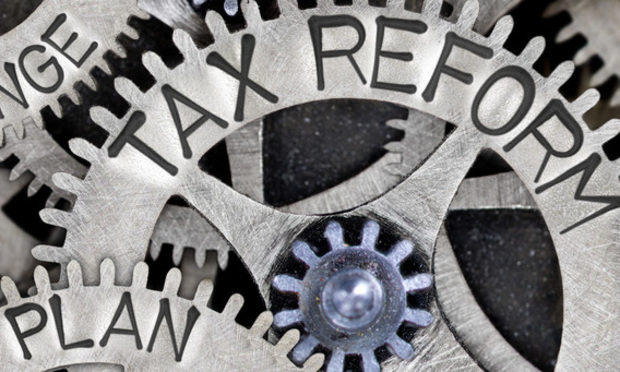New 20 Percent C Corporation Tax Rate — Look Before You Leap
The 20 percent corporate tax rate in both the House and Senate tax bills creates a huge benefit for growing companies that are reinvesting earnings.…
December 05, 2017 at 11:55 AM
5 minute read

The 20 percent corporate tax rate in both the House and Senate tax bills creates a huge benefit for growing companies that are reinvesting earnings. Businesses now taxed as flow-throughs — which includes S corporations and entities taxed as partnerships, such as LLCs — may stampede to become so-called C corporations if and when the pending tax legislation is enacted.
Most privately owned businesses have migrated to flow-through tax status in the last 20 years primarily to avoid the double tax regime for C corporations. Current tax law imposes a small penalty on flow-through owners for avoiding double tax, i.e. a 39.6 percent rate for individuals versus a 34-35 percent rate for corporations on current earnings (and a combined double tax burden in excess of 50 percent). But the pending tax legislation may materially change this, making C corporation status irresistible, particularly for fast-growing enterprises.
The Senate and House tax bills have very similar structures, making enactment very likely, but the bills vary in important ways. What happens in the midnight political knife fight to arrive at a final bill may determine which direction a business should go.
While both bills provide for a 20 percent tax rate for C corporations, the maximum tax rate on flow-throughs is under 30 percent under the Senate bill and 25 percent for passive income under the House bill. Curiously, flow-through tax rates under the House bill are higher for active owners of flow-throughs. These rates are the critical part of the final political calculus.
But becoming a C corporation can be a one-way street creating significant future tax pain with no easy way out. C corporation tax pain hits when it's time to return earnings and appreciation to shareholders, as such amounts are taxed a second time, triggering combined federal tax rates which often exceed 50 percent. In contrast, owners of flow-through businesses are taxed once on company income, including 20 percent long-term capital gains on goodwill when the business's assets are sold. Again, pending legislation will dramatically change these numbers and companies need to consider these issues to remain competitive.
Once a business is taxed as a C corporation it can be painful to change back to flow-through tax status. A C corporation whose shareholders are U.S. individuals (or trusts for such persons) may be eligible to be taxed as a flow-through via an S election, but will be exposed to corporate-level tax for five years on so called built-in gain as of the date of the S election. A C corporation with multiple classes of stock or shareholders who are not U.S. individuals may not be able to make an S election and will trigger potentially devastating corporate and shareholder-level taxes if converted to a flow-through entity.
The C corporation double-tax regime may make selling the assets of a company prohibitively expensive. A stock sale avoids the double tax, but shifts the seller's double-tax problem to the buyer, who will likely exact some form of tax haircut to the purchase price.
A decision to move from flow-through taxation to C corporation status should consider several items, some of which can be computed once final legislation is passed but others are subjective nontax items. Computable items include (i) federal tax rate differential on current income including effective rates, (ii) federal tax rate on dividends and distributions to owners, (iii) effect of state and local income taxes, particularly on income of flow-through entities, and (iv) tax items unique to the business and its owners such as non-U.S. earnings and the alternative minimum tax. Subjective items include (i) the timing and amount of future distributions to owners, (ii) the timing and amount of gain on a sale of the business, (iii) the ability to avoid C corporation double tax via a future S election or other exit strategies, and (iv) likely exit strategies and the tax posture of any potential buyers.
Once the political dust settles on tax legislation, each business should promptly assess its tax structure to maximize its after tax return to its owners. The effective date of tax changes is likely Jan. 1, 2018, with limited ability to change a company's tax status retroactively. Modeling alternative outcomes is the most effective way to make the best decision. Simply listing the pros and cons often masks the dollar effect of variables and may not identify sometimes significant issues. General counsel can be a critical member of the team by helping establish the underlying assumptions and future expectations for the business and its owners.
John Ransom is a transaction and tax lawyer in the Houston office of Jackson Walker, where he leads the firm's Houston corporate practice group. Also a CPA, he advises business clients on the tax and other aspects of choice of entity, acquisitions & dispositions, capitalization & financing alternatives and management equity incentives.
This content has been archived. It is available through our partners, LexisNexis® and Bloomberg Law.
To view this content, please continue to their sites.
Not a Lexis Subscriber?
Subscribe Now
Not a Bloomberg Law Subscriber?
Subscribe Now
NOT FOR REPRINT
© 2025 ALM Global, LLC, All Rights Reserved. Request academic re-use from www.copyright.com. All other uses, submit a request to [email protected]. For more information visit Asset & Logo Licensing.
You Might Like
View All

Nondisparagement Clauses in Divorce: Balancing Family Harmony and Free Speech
6 minute read

Trending Stories
- 1The New Rules of AI: Part 2—Designing and Implementing Governance Programs
- 2Plaintiffs Attorneys Awarded $113K on $1 Judgment in Noise Ordinance Dispute
- 3As Litigation Finance Industry Matures, Links With Insurance Tighten
- 4The Gold Standard: Remembering Judge Jeffrey Alker Meyer
- 5NJ Supreme Court Clarifies Affidavit of Merit Requirement for Doctor With Dual Specialties
Who Got The Work
J. Brugh Lower of Gibbons has entered an appearance for industrial equipment supplier Devco Corporation in a pending trademark infringement lawsuit. The suit, accusing the defendant of selling knock-off Graco products, was filed Dec. 18 in New Jersey District Court by Rivkin Radler on behalf of Graco Inc. and Graco Minnesota. The case, assigned to U.S. District Judge Zahid N. Quraishi, is 3:24-cv-11294, Graco Inc. et al v. Devco Corporation.
Who Got The Work
Rebecca Maller-Stein and Kent A. Yalowitz of Arnold & Porter Kaye Scholer have entered their appearances for Hanaco Venture Capital and its executives, Lior Prosor and David Frankel, in a pending securities lawsuit. The action, filed on Dec. 24 in New York Southern District Court by Zell, Aron & Co. on behalf of Goldeneye Advisors, accuses the defendants of negligently and fraudulently managing the plaintiff's $1 million investment. The case, assigned to U.S. District Judge Vernon S. Broderick, is 1:24-cv-09918, Goldeneye Advisors, LLC v. Hanaco Venture Capital, Ltd. et al.
Who Got The Work
Attorneys from A&O Shearman has stepped in as defense counsel for Toronto-Dominion Bank and other defendants in a pending securities class action. The suit, filed Dec. 11 in New York Southern District Court by Bleichmar Fonti & Auld, accuses the defendants of concealing the bank's 'pervasive' deficiencies in regards to its compliance with the Bank Secrecy Act and the quality of its anti-money laundering controls. The case, assigned to U.S. District Judge Arun Subramanian, is 1:24-cv-09445, Gonzalez v. The Toronto-Dominion Bank et al.
Who Got The Work
Crown Castle International, a Pennsylvania company providing shared communications infrastructure, has turned to Luke D. Wolf of Gordon Rees Scully Mansukhani to fend off a pending breach-of-contract lawsuit. The court action, filed Nov. 25 in Michigan Eastern District Court by Hooper Hathaway PC on behalf of The Town Residences LLC, accuses Crown Castle of failing to transfer approximately $30,000 in utility payments from T-Mobile in breach of a roof-top lease and assignment agreement. The case, assigned to U.S. District Judge Susan K. Declercq, is 2:24-cv-13131, The Town Residences LLC v. T-Mobile US, Inc. et al.
Who Got The Work
Wilfred P. Coronato and Daniel M. Schwartz of McCarter & English have stepped in as defense counsel to Electrolux Home Products Inc. in a pending product liability lawsuit. The court action, filed Nov. 26 in New York Eastern District Court by Poulos Lopiccolo PC and Nagel Rice LLP on behalf of David Stern, alleges that the defendant's refrigerators’ drawers and shelving repeatedly break and fall apart within months after purchase. The case, assigned to U.S. District Judge Joan M. Azrack, is 2:24-cv-08204, Stern v. Electrolux Home Products, Inc.
Featured Firms
Law Offices of Gary Martin Hays & Associates, P.C.
(470) 294-1674
Law Offices of Mark E. Salomone
(857) 444-6468
Smith & Hassler
(713) 739-1250






